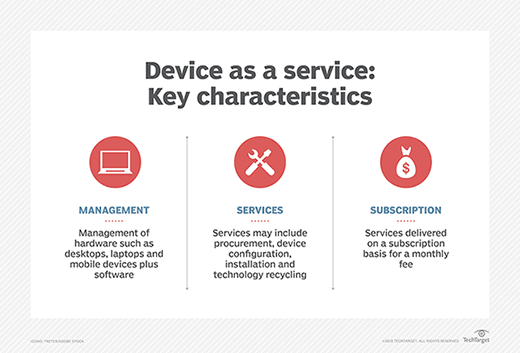device as a service (DaaS)
What is device as a service?
The device as a service (DaaS) model offers PCs, smartphones and other mobile computing devices as a paid service. Device as a service eases the IT needs of a company by outsourcing the hardware, software and device management to an external provider. Subscribing to a provider would allow an organization to update its equipment at the end of the lease period without incurring the costs that would normally be associated with a device refresh.
Software and hardware management services include device backups, asset tracking, security and end-of-life disposal. Devices offered as a service include hardware such as PCs, laptops, desktops, tablets, two-in-ones or mobile phones.
Vendors provide a contract stating the hardware, software, services, amounts and lengths of time required for device as a service and payment is normally on a per-device basis. Some OEMs offer device as a service with a somewhat limited number of choices from their overall device lineup. Users cannot replace hardware they are using from a vendor when they wish. Typically, a contract states two, three or five-year timelines for device replacement.
Devices typically come with the software the organization needs already installed. Usually, a vendor also includes a visible upgrade path for patches and updates.
This article is part of
What is desktop management and how does it work?

The trend for using device as a service has been quick to grow, starting from a meager beginning, with only 1% of PCs shipped as part of a device-as-a-service program in 2014. Based on market research from Grand View Research, "the global device-as-a-service market size was valued at USD 30.75 billion in 2020 and is expected to expand at a compound annual growth rate (CAGR) of 37.8% from 2021 to 2028."
What are the benefits of device as a service?
Device as a service can bring various benefits, mostly for smaller startup organizations. These benefits may include the following:
- Organizations can scale devices up and down as needed, although scaling down can usually be done only at the end of the contract period.
- Costs are changed from capital expenditures to operating expenses.
- IT staff has reduced workload because device configuration is no longer required.
- It includes automatic device management, such as patches and updates.
- It gives startups the ability to acquire a collection of devices without the normal, high upfront cost.
- It's a good option for smaller companies that lack in-house IT expertise.
- Device as a service gives organizations the option of trading up for newer devices at the end of the contract period.
Potential drawbacks of the device-as-a-service model
Although many potential benefits are associated with the device-as-a-service model, organizations should also consider the possible disadvantages, which include the following:
- The organization never actually owns the devices, even though it is paying for devices in perpetuity.
- Despite vendor claims to the contrary, the total cost of ownership may be higher in some cases.
- Because vendors service and maintain devices, privacy may be a concern.
- It might not be an option in certain regulated industries.
- Device selection may be limited to certain models.
Common device-as-a-service options
Two primary examples of device as a service include offerings from HP and Lenovo. HP offers HP Device as a Service, which has device options ranging from commercial notebooks, desktops and specialized devices. It has even expanded to offering hardware outside of HP's hardware, such as Apple Macs, iPhones and iPads.
Lenovo has also started a device-as-a-service initiative. Lenovo offers customers a wide range of devices such as PCs, tablets, smartphones, and video conferencing and collaboration tools.
Device as a service vs. desktop as a service
Device as a service shares the DaaS acronym with desktop as a service, which can be confusing when using the name or acronym. With device as a service, physical hardware is offered to customers under a subscription model. This may include PCs, tablets, smartphones or other physical devices.
Desktop as a service, on the other hand, is a cloud computing offering where a third party offers a virtual desktop running on a cloud-based virtual machine (VM). The desktop-as-a-service provider hosts the back end of a virtual desktop infrastructure deployment, and the guest operating system runs inside a VM on a physical server that resides in the cloud service provider's data center. Desktop-as-a-service providers bill their customers monthly, based on the number of virtual desktops they are using. In contrast, device as a service usually requires an annual or multi-year commitment.







